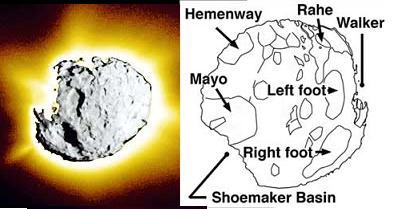Who said that a comet is a boring block of ice * Images of the comet "Wilt 2", in which deep craters and tall pillars, amaze the researchers
John Noble Wilford, Haaretz, voila!

Comet "Wilt 2". Huge jets of gas and dust splashed into space
The most detailed close-up images of a comet ever taken are awestruck by scientists. The rugged and varied landscape of comet Wilt 2 is unlike anything they have ever seen or imagined: towering pillars rising above deep craters, and massive jets of gas and dust spewing into space.
"We were shocked by what we saw," said this weekend Dr. Donald Brownlee from the University of Washington, head of the research team, at a NASA press conference where the findings from the "Stardust" spacecraft were announced. The spacecraft which approached to a distance of 237 km from the comet on January 2 of this year.
It seems that "Wilt 2", named after a Swiss astronomer, also left its mark on the spacecraft, which weighs 350 kg. A dozen particles ejected from the comet, some larger than a gun bullet, penetrated through the outer layer of the mantle that protects the spacecraft. "It was like lightning strikes," said Dr. Anthony Tozzolino, a senior scientist at the Fermi Institute at the University of Chicago, in a statement issued by the university. "I did not expect to come across an event of this kind," he said.
But the spacecraft withstood the attack, and sent samples of the comet's dust to Earth. Brownlee and other researchers gave preliminary but detailed reports on the encounter between the spacecraft and the comet in articles published last week in the journal "Science".
The comet, which is five kilometers in diameter, looks different from any other object in the solar system that has been examined before. Is this a typical or unusual comet? Astronomers, who relied among other things on the composition of Halley's comet, assumed until now that comets resemble dirty snowballs - accumulations of ice and debris from space. It was estimated that these stars emit dust and gas, but not with the intensity encountered by the spacecraft.
"We feel astonishment, along with great curiosity, following what we saw in the encounter with 'Stradast,'" said Dr. Claudia Alexander, an astronomer at NASA's Jet Propulsion Laboratory in Pasadena, California, who specializes in the study of comets.
Brownlee said the landscape of Wilt 2 reminds him of the pillars of Monument Valley in Arizona, which were left standing after the rest of the surface was eroded and washed away by erosion. The pillars of the comet rise to a height of more than 100 meters and its craters reach a width of 150 meters. If it is indeed drift and surface erosion, Brownlee added, then the comet appears to have lost more than 100 meters of its mantle layer on its travels through the solar system.
According to the researchers, the strangest structures on the surface of the comet are two deep depressions with a flat bottom and steep walls. The two structures look like two giant footprints. On a map of the comet they are marked "left leg" and "right leg".
The scientists hypothesized that evaporation and impact of objects from space created the rough surface of the planet. The powerful jets may be formed when the sun's rays strike the ice at or just below the surface. The ice turned into gas which spewed into space at speeds of hundreds of kilometers per hour.
Dr. Alexander said that the scientists were deeply impressed by the shape differences between Willet 2 and Phoebe, a small moon of the planet Saturn near which the Cassini spacecraft passed about two weeks ago. The moon Phoebe is hypothesized to have been captured in the gravitational field of Saturn, and originated, like the origin of "Wilt 2" and other comets, in the cold fringes of the solar system beyond the planets.
The origin of the two objects may be from the same remote area, but according to Alexander, their histories are different. "Phoebe" was captured a long time ago by Saturn and remains in orbit around it. But "Wilt 2" apparently passed through very different environments, as it moved deep into space and approached the heat of the sun.
Dr. Benton Clark, a scientist involved in the Stardust project on behalf of Lockheed Martin, reported that the instruments in the spacecraft revealed that the comet's dust particles are rich in organic matter. This may be important, he said, because some astronomers have argued that comets may have "seeded" Earth with the organic elements of life.
Flying through the dust surrounding Willet 2, the spacecraft collected thousands of particles that are now making their way to Earth for more in-depth research. A spacecraft with the exotic cargo inside is expected to land in the Utah deserts in January 2006.
